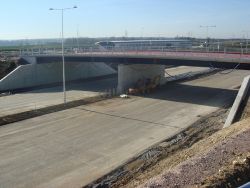Roadworks
| Roadworks | |
 | |
| Roadworks on the A2 in 2008 | |
| Pictures related to Roadworks View gallery (1214) | |
Roadworks is a generic term for any maintenance or new construction work carried out on public roads. They may range in scale from filling in potholes to construction of major improvements to the road. They may also include works carried out by utility companies, for example emergency repairs to gas mains, replacement of worn out pipes, or provision of new services for development.
Maintenance Schemes
These include emergency works, routine works, carriageway resurfacing, surface dressing, carriageway reconstruction
Minor Schemes
Minor schemes are smaller schemes that change the road layout. These range from adding a new road sign right the way through to junction realignments. There are many reasons for carrying out minor schemes, for example:
- Road safety schemes;
- Local improvement schemes such as the provision of new facilities such as bus lanes, cycle lanes, pedestrian crossings, new signage or any other features to provide local benefits;
- Introduction of new traffic orders, for example changes to parking restrictions or speed limits;
- Junction improvements to provide more capacity; and
- Schemes to provide access to new developments.
They are usually of local importance and are relatively quick to build.
Major Schemes
Major schemes are significant changes to the road network, for example new road construction or large junction improvements. They are often schemes of regional or national importance and can take a long time to build due to the size and complexity of the project. Major schemes can include the construction of entirely new roads, for example a new bypass, or they can be an improvement to the existing network, for example carriageway widening or junction improvements.
Major schemes are usually funded by the government, though occasionally they may be promoted as a catalyst for redevelopment, with significant funding provided by developers.
Examples of major schemes include:
- Catthorpe Interchange
- A30 Temple
- A1(M) Upgrades
- Smart Motorway schemes
- Bridge strengthening / replacement schemes
Utility Works
Utility companies have a right enshrined in the New Roads and Streetworks Act 1991 (NRSWA) to install and maintain utility services within the public highway. NRSWA provides a mechanism for Highway Authorities and Utility Companies to serve notice on each other when one entity wishes to do works that will affect the other.
Utility works range from emergency repairs to provision of new services to individual plots, or to entire developments. They may also include the diversion or protection of buried services required to allow the modification of the highway, for example carriageway widening or new road construction.
Signing and Guarding of Roadworks
Roadworks should be protected by temporary cones, barriers and signs laid out in accordance with Chapter 8 of the Traffic Signs Manual for schemes on high speed roads, or Safety at Street Works and Road Works - A Code of Practice for all other works. See Warning Sign/Roadworks for further information.
Simple layouts
These are used for works that are either on very lightly trafficked roads, or which don't restrict the road width down to one lane. On lightly trafficked roads, opposing traffic may pass each other by give and take if there is only room for one lane past the works.
Stop/Go Boards
As traffic levels build, Stop/Go boards may be used to control traffic passing the restriction. They are manually operated, and depending on the length of the works, there may be a single stop/go board, or a pair of stop/go boards, one at either end, with the operators either working by line of sight or by radio contact.
Temporary Traffic Signals
When conditions are too busy for stop/go boards, temporary traffic signals may be used instead. They can either be two-way signals (that is, one signal head at either end of the works), or where junctions are involved, three- and four-way signals can be used. Temporary pedestrian crossings are now also available.
Contraflow
Dual carriageways and motorways may run in contraflow where traffic runs in both directions on one carriageway. The requirements for laying out contraflows has become more onerous since the 1960s when a minimal amount of cones were used, to the present day where extensive temporary barrier systems are used.
An example of a 1960s contraflow can be seen next to the Brynglas Tunnels on the M4 at Newport. The full article is here
Mobile works
Guarded by slow moving large lorries equipped with signs to direct traffic around the works vehicles.
| Pictures related to Roadworks View gallery (1214) |
Videos
M62 J26 to J27
Travelling along the M62 from the roundabout under J26 heading up the eastbound sliproad and through the roadworks
This article started life as a discussion on the SABRE forums




